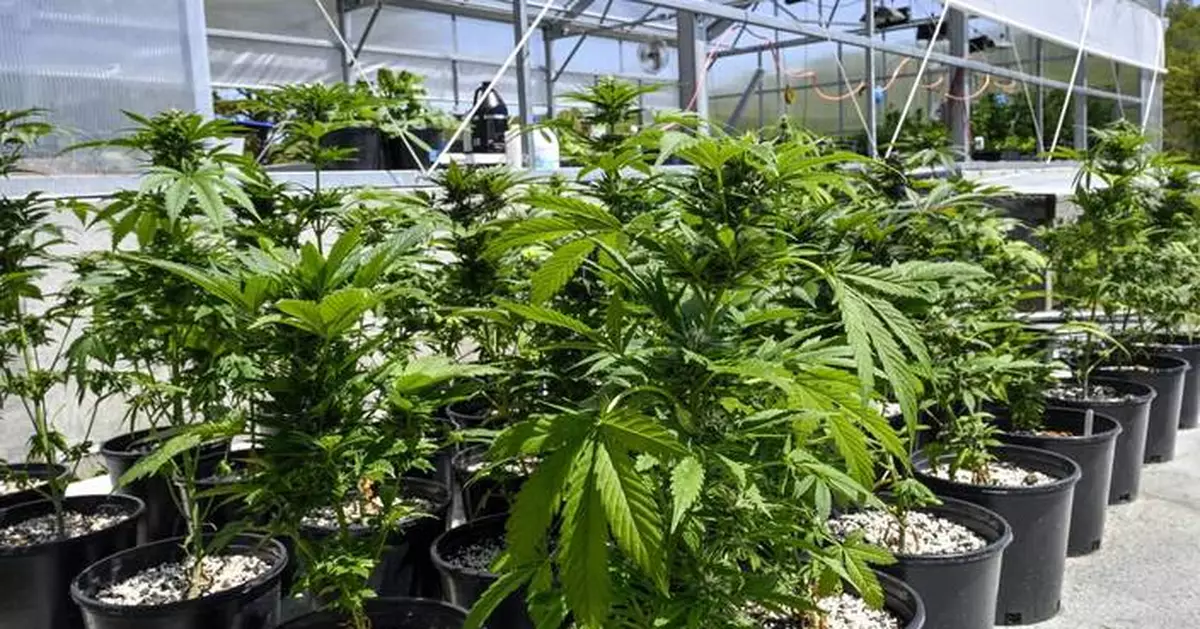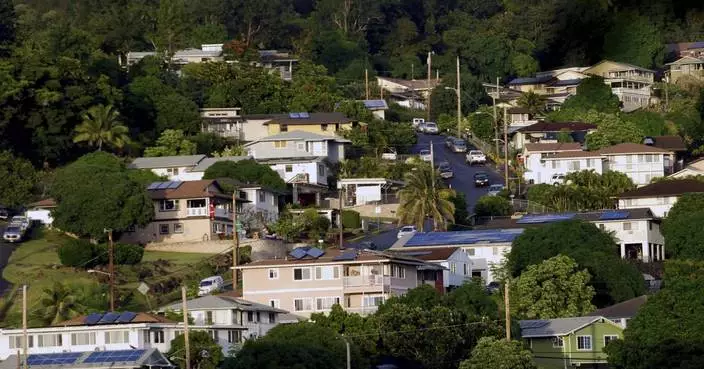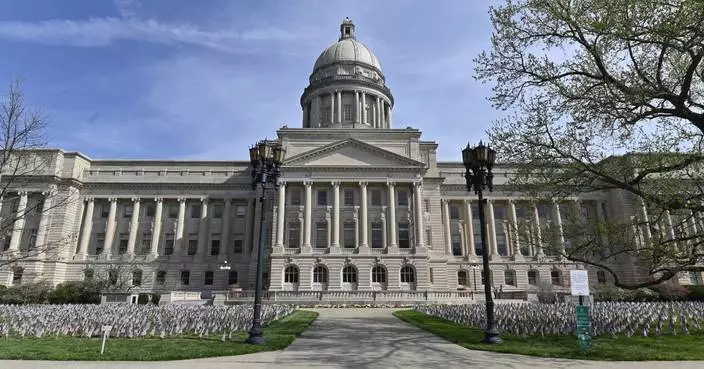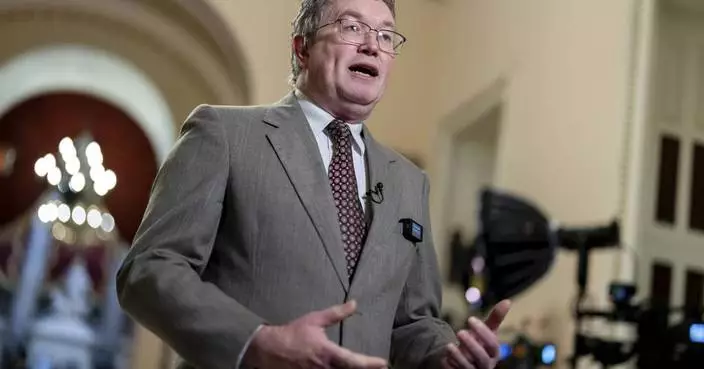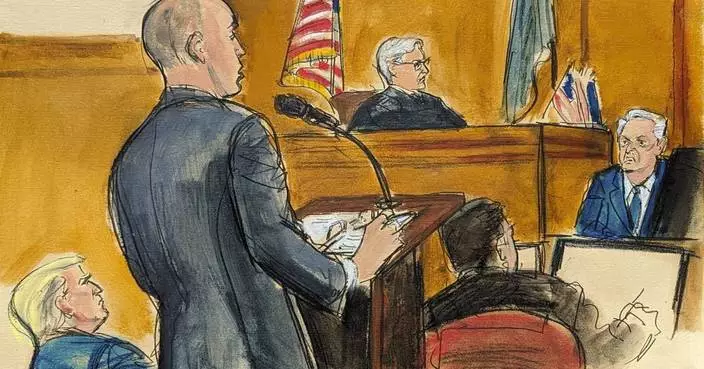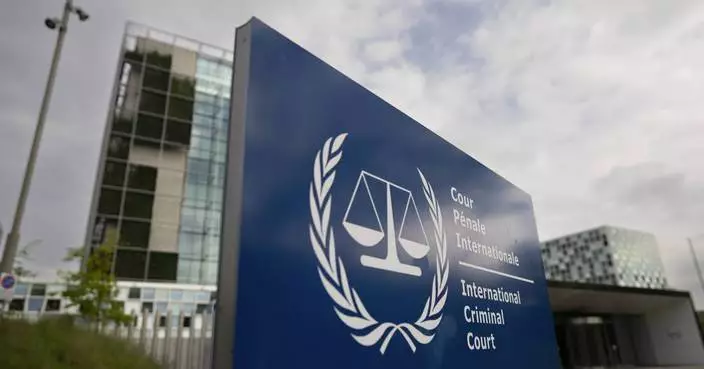WASHINGTON (AP) — The U.S. Drug Enforcement Administration is moving toward reclassifying marijuana as a less dangerous drug. The Justice Department proposal would recognize the medical uses of cannabis, but wouldn't legalize it for recreational use.
The proposal would move marijuana from the “Schedule I” group to the less tightly regulated “Schedule III."
So what does that mean, and what are the implications?
Technically, nothing yet. The proposal must be reviewed by the White House Office of Management and Budget, and then undergo a public-comment period and review from an administrative judge, a potentially lengthy process.
Still, the switch is considered “paradigm-shifting, and it’s very exciting,” Vince Sliwoski, a Portland, Oregon-based cannabis and psychedelics attorney who runs well-known legal blogs on those topics, told The Associated Press when the federal Health and Human Services Department recommended the change.
“I can’t emphasize enough how big of news it is,” he said.
It came after President Joe Biden asked both HHS and the attorney general, who oversees the DEA, last year to review how marijuana was classified. Schedule I put it on par, legally, with heroin, LSD, quaaludes and ecstasy, among others.
Biden, a Democrat, supports legalizing medical marijuana for use “where appropriate, consistent with medical and scientific evidence,” White House press secretary Karine Jean-Pierre said Thursday. “That is why it is important for this independent review to go through.”
No. Schedule III drugs — which include ketamine, anabolic steroids and some acetaminophen-codeine combinations — are still controlled substances.
They're subject to various rules that allow for some medical uses, and for federal criminal prosecution of anyone who traffics in the drugs without permission.
No changes are expected to the medical marijuana programs now licensed in 38 states or the legal recreational cannabis markets in 23 states, but it's unlikely they would meet the federal production, record-keeping, prescribing and other requirements for Schedule III drugs.
There haven't been many federal prosecutions for simply possessing marijuana in recent years, even under marijuana’s current Schedule I status, but the reclassification wouldn't have an immediate impact on people already in the criminal justice system.
“Put simple, this move from Schedule I to Schedule III is not getting people out of jail,” said David Culver, senior vice president of public affairs at the U.S. Cannabis Council.
But rescheduling in itself would have some impact, particularly on research and marijuana business taxes.
Because marijuana is on Schedule I, it's been very difficult to conduct authorized clinical studies that involve administering the drug. That has created something of a Catch-22: calls for more research, but barriers to doing it. (Scientists sometimes rely instead on people’s own reports of their marijuana use.)
Schedule III drugs are easier to study, though the reclassification wouldn't immediately reverse all barriers to study.
“It’s going to be really confusing for a long time,” said Ziva Cooper, director of the University of California, Los Angeles Center for Cannabis and Cannabinoids. “When the dust has settled, I don’t know how many years from now, research will be easier.”
Among the unknowns: whether researchers will be able to study marijuana from state-licensed dispensaries and how the federal Food and Drug Administration might oversee that.
Some researchers are optimistic.
“Reducing the schedule to schedule 3 will open up the door for us to be able to conduct research with human subjects with cannabis,” said Susan Ferguson, director of University of Washington’s Addictions, Drug & Alcohol Institute in Seattle.
Under the federal tax code, businesses involved in “trafficking” in marijuana or any other Schedule I or II drug can't deduct rent, payroll or various other expenses that other businesses can write off. (Yes, at least some cannabis businesses, particularly state-licensed ones, do pay taxes to the federal government, despite its prohibition on marijuana.) Industry groups say the tax rate often ends up at 70% or more.
The deduction rule doesn't apply to Schedule III drugs, so the proposed change would cut cannabis companies' taxes substantially.
They say it would treat them like other industries and help them compete against illegal competitors that are frustrating licensees and officials in places such as New York.
“You’re going to make these state-legal programs stronger,” says Adam Goers, of The Cannabist Company, formerly Columbia Care. He co-chairs a coalition of corporate and other players that’s pushing for rescheduling.
It could also mean more cannabis promotion and advertising if those costs could be deducted, according to Beau Kilmer, co-director of the RAND Drug Policy Center.
Rescheduling wouldn't directly affect another marijuana business problem: difficulty accessing banks, particularly for loans, because the federally regulated institutions are wary of the drug's legal status. The industry has been looking instead to a measure called the SAFE Banking Act. It has repeatedly passed the House but stalled in the Senate.
Indeed, there are, including the national anti-legalization group Smart Approaches to Marijuana. President Kevin Sabet, a former Obama administration drug policy official, said the HHS recommendation “flies in the face of science, reeks of politics” and gives a regrettable nod to an industry “desperately looking for legitimacy.”
Some legalization advocates say rescheduling weed is too incremental. They want to keep the focus on removing it completely from the controlled substances list, which doesn't include such items as alcohol or tobacco (they're regulated, but that's not the same).
Paul Armentano, the deputy director of the National Organization for the Reform of Marijuana Laws, said that simply reclassifying marijuana would be “perpetuating the existing divide between state and federal marijuana policies.” Kaliko Castille, a past president of the Minority Cannabis Business Association, said rescheduling just "re-brands prohibition," rather than giving an all-clear to state licensees and putting a definitive close to decades of arrests that disproportionately pulled in people of color.
“Schedule III is going to leave it in this kind of amorphous, mucky middle where people are not going to understand the danger of it still being federally illegal,” he said.
This story has been corrected to show that Kaliko Castille is a past president, not president, of the Minority Cannabis Business Association and that Columbia Care is now The Cannabist Company.

Cloud 9 Cannabis employee Beau McQueen, right, helps a customer, Saturday, April 13, 2024, in Arlington, Wash. The shop is one of the first dispensaries to open under the Washington Liquor and Cannabis Board's social equity program, established in efforts to remedy some of the disproportionate effects marijuana prohibition had on communities of color. (AP Photo/Lindsey Wasson)

Budtender Rey Cruz weighs cannabis for a customer at the Marijuana Paradise on Friday, April 19, 2024, in Portland, Ore. (AP Photo/Jenny Kane)

FILE - Marijuana plants are seen at a secured growing facility in Washington County, N.Y., May 12, 2023. The U.S. Drug Enforcement Administration will move to reclassify marijuana as a less dangerous drug, a historic shift to generations of American drug policy that could have wide ripple effects across the country. (AP Photo/Hans Pennink, File)
GREENFIELD, Iowa (AP) — Powerful storms that rolled through the Midwest spun up multiple tornadoes, including a fierce twister that smashed through a small Iowa town Tuesday, carving a bleak landscape of destroyed homes and businesses, toppled trees, smashed cars and widely strewn debris and causing an unknown number of injuries.
Iowa State Patrol spokesman Sgt. Alex Dinkla said multiple people were injured in Greenfield, a town of about 2,000 around 55 miles (88.5 kilometers) southwest of Des Moines, and there was a lot of damage in town. He didn’t know the extent of the injuries.
In the aftermath of the storm, parts of Greenfield appeared devastated. Mounds of broken wood, branches, car parts and other debris littered lots where homes once stood. Cars lay busted and bent while damaged houses sat skewed against the gray and overcast sky. Trees stood — barely — bereft of branches or leaves.
Multiple tornadoes were reported throughout the state, and one also apparently took down several 250-foot (76 meters) wind turbines. Des Moines, Iowa, television station KCCI-TV showed at least three wind turbines that were toppled by an apparent tornado in southwest Iowa, and at least one was in flames with black smoke pluming from the bent structure.
Wind farms are built to withstand tornadoes, hurricanes and other powerful winds. According to the U.S. Department of Energy, turbines are designed shut off when winds exceed certain thresholds, typically around 55 mph (88.5 kph). They also lock and feather their blades, and turn into the wind, to minimize the strain.
The Adair County Health System hospital in Greenfield was damaged in the storm, but Mercy One spokesman Todd Mizener said he had no further details. The hospital is affiliated with Mercy One, and officials were on their way to Greenfield to assess the damage.
Mary Long, the owner of Long’s Market in downtown Greenfield, said she rode out the storm at her business in the community’s historic town square, which largely escaped damage. Long said there appeared to be widespread damage on the east and south sides of town.
“I could hear this roaring, like the proverbial freight train, and then it was just done,” she said.
Camille Blair said the Greenfield Chamber of Commerce office where she works closed around 2 p.m. ahead of the storm. She emerged from her home to describe widespread damage and scattered debris.
“There’s a pretty significant roof damage to several houses that I know will need whole new roofs," she said. "And I can see from my house it kind of went in a straight line down the road.”
In far southwestern Iowa, video posted to social media showed a tornado just northwest of Red Oak. Further east and north, the National Weather Service issued multiple tornado warnings for areas near the towns of Griswold, Corning, Fontanelle and Guthrie Center, among others.
Iowa was already braced for severe weather after the National Weather Service’s Storm Prediction Center gave most of the state a high chance of seeing severe thunderstorms with the potential for strong tornadoes. Des Moines public schools ended classes two hours early and canceled all evening activities ahead of the storms.
Earlier in the day, residents to the west in Omaha, Nebraska, awoke to weather sirens blaring and widespread power outages as torrential rain, high winds and large hail pummeled the area. The deluge of more than 5 inches (12.7 centimeters) of rain in less than two hours flooded basements and submerged cars. Television station KETV showed firefighters arriving to rescue people from vehicles.
In Illinois, dust storms forced authorities to shut down stretches of two interstates due to low visibility. Winds gusts of between 35 mph (56 kph) and 45 mph (74 kph) hit the McLean area, according to National Weather Service meteorologist Chuck Schaffer.
“There is no visibility at times,” state police posted on X, formerly Twitter.
The storms followed days of extreme weather that have ravaged much of the middle section of the country. Strong winds, large hail and tornadoes swept parts of Oklahoma and Kansas late Sunday, damaging homes and injuring two in Oklahoma.
Another round of storms Monday night raked Colorado and western Nebraska and saw the city of Yuma, Colorado, blanketed in hail the size of baseballs and golf balls, turning streets into rivers of water and ice. Front-end loaders were used to move half-foot deep (1.83 meters deep) hail Tuesday.
Last week, deadly storms hit the Houston area in Texas, killing at least seven. Those storms Thursday knocked out power to hundreds of thousands for days, leaving those Texans in the dark and without air conditioning during hot and humid weather. Hurricane-force winds reduced businesses and other structures to debris and shattered glass in downtown skyscrapers.
Tuesday's storms were expected to bring much of the same high winds, heavy rain and large hail to Minnesota and part of northern Missouri, said Bob Oravec, lead forecaster with the National Weather Service.
He said the system is expected to turn south on Wednesday, bringing more severe weather to parts of Texas, Oklahoma, Arkansas and southern Missouri.
—-
McFetridge reported from Des Moines, Iowa, and Beck reported from Omaha, Nebraska. Associated Press writers Steve Karnowski in Minneapolis, Josh Funk in Omaha and Colleen Slevin in Denver contributed to this report.

This image provided by JJ Unger, shows hail damage to the window of vehicle, Monday night, May 20, 2024, in Yuma, Colo. Residents in the small city in northeastern Colorado were cleaning up Tuesday after hail the size of baseballs and golf balls pounded the community, with heavy construction equipment and snow shovels being used to clear hail that had piled up knee-deep the night before. (JJ Unger via AP)
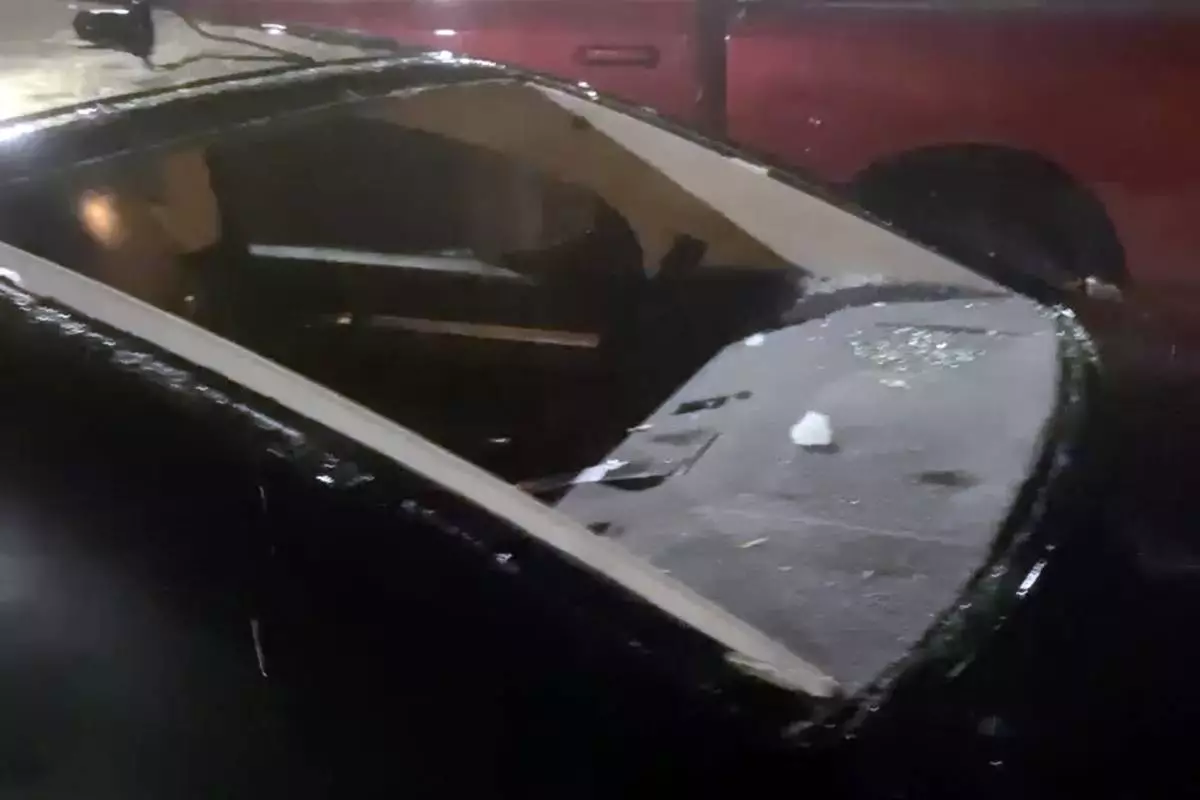
This image taken from video provided by JJ Unger, shows hail damage to a window of vehicle, Monday night, May 20, 2024, in Yuma, Colo. Residents in the small city in northeastern Colorado were cleaning up Tuesday after hail the size of baseballs and golf balls pounded the community, with heavy construction equipment and snow shovels being used to clear hail that had piled up knee-deep the night before. (JJ Unger via AP)

This image provided by JJ Unger, shows hail surrounding a vehicle, Monday night, May 20, 2024, in Yuma, Colo. Residents in the small city in northeastern Colorado were cleaning up Tuesday after hail the size of baseballs and golf balls pounded the community, with heavy construction equipment and snow shovels being used to clear hail that had piled up knee-deep the night before. (JJ Unger via AP)

Workers clean out shattered glass at the Wells Fargo building as clean up from the previous week's storm continues in downtown Houston, Monday, May 20, 2024. The city closed off streets in a six-block exclusion zone downtown, from McKinney to Polk and from Smith to Travis to ease traffic around the area where broken glass and debris are prevalent. (Brett Coomer/Houston Chronicle via AP)
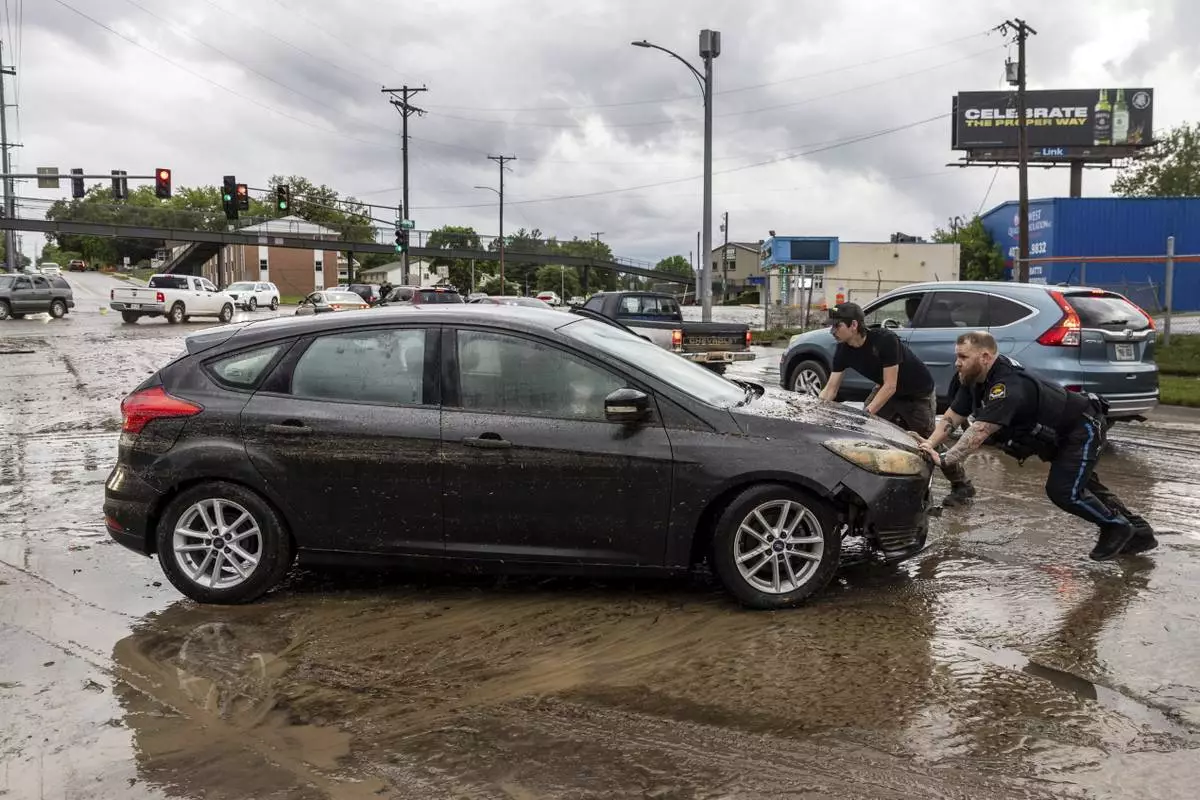
A police officer and an employee of nearby Dingman's Collision Center push a car that had been caught in flood waters in Omaha, Neb. on Tuesday, May 21, 2024 (Chris Machian /Omaha World-Herald via AP)
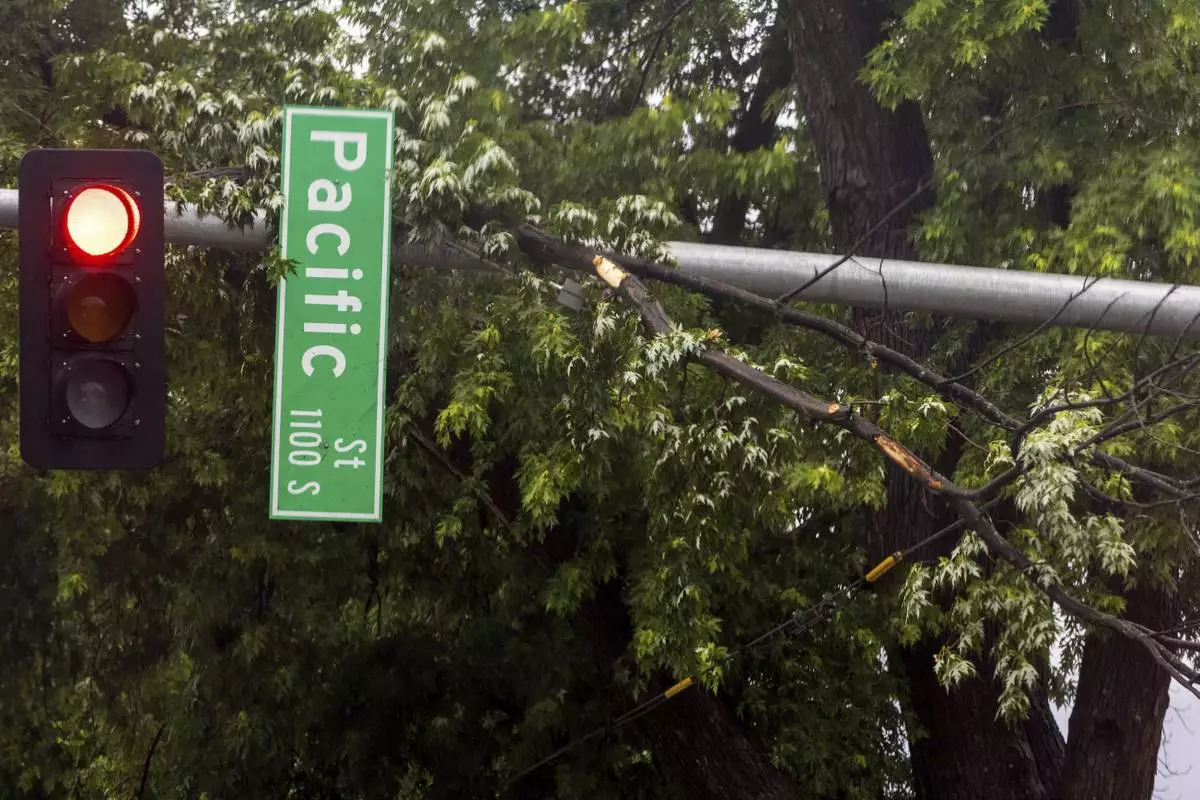
An early-morning storm knock tree branches onto the Pacific Street sign on 42nd Street in Omaha, Neb. on Tuesday, May 21, 2024. (Chris Machian /Omaha World-Herald via AP)
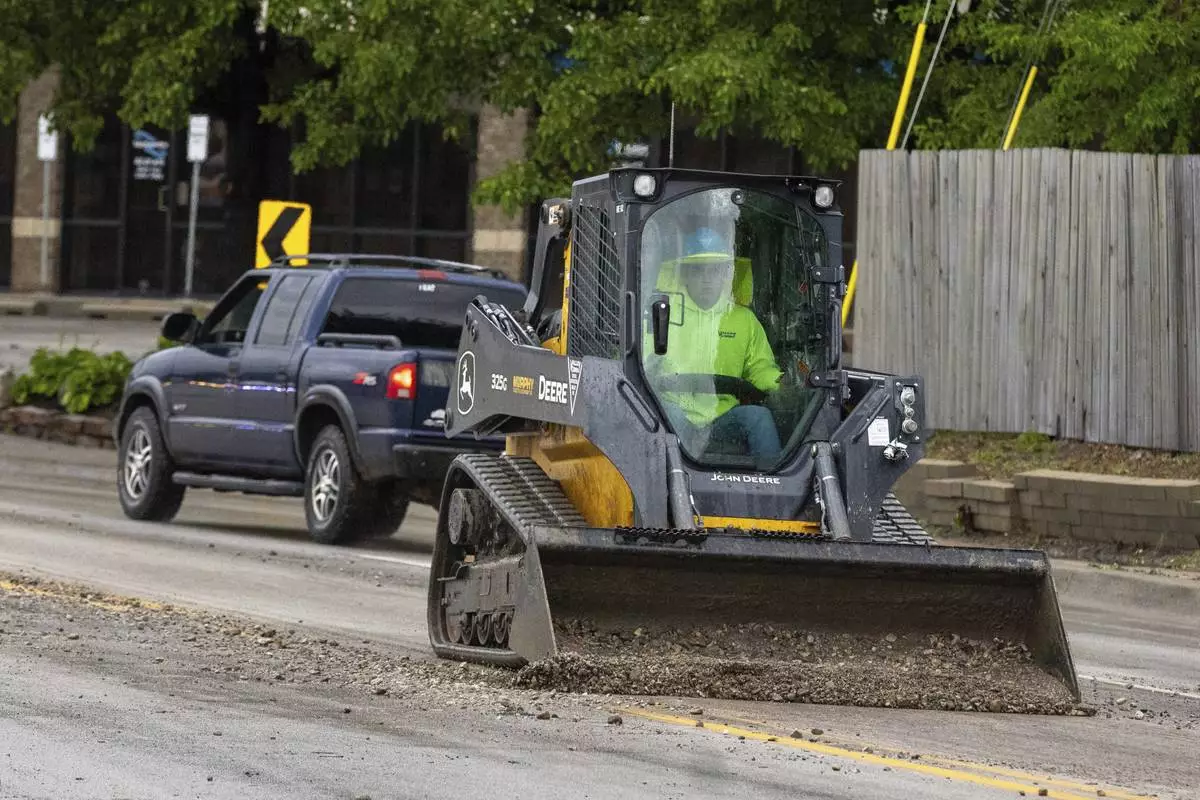
Heavy machinery clears debris washed out by flooding from nearby construction sites in Omaha, Neb. on Tuesday, May 21, 2024. (Chris Machian /Omaha World-Herald via AP)
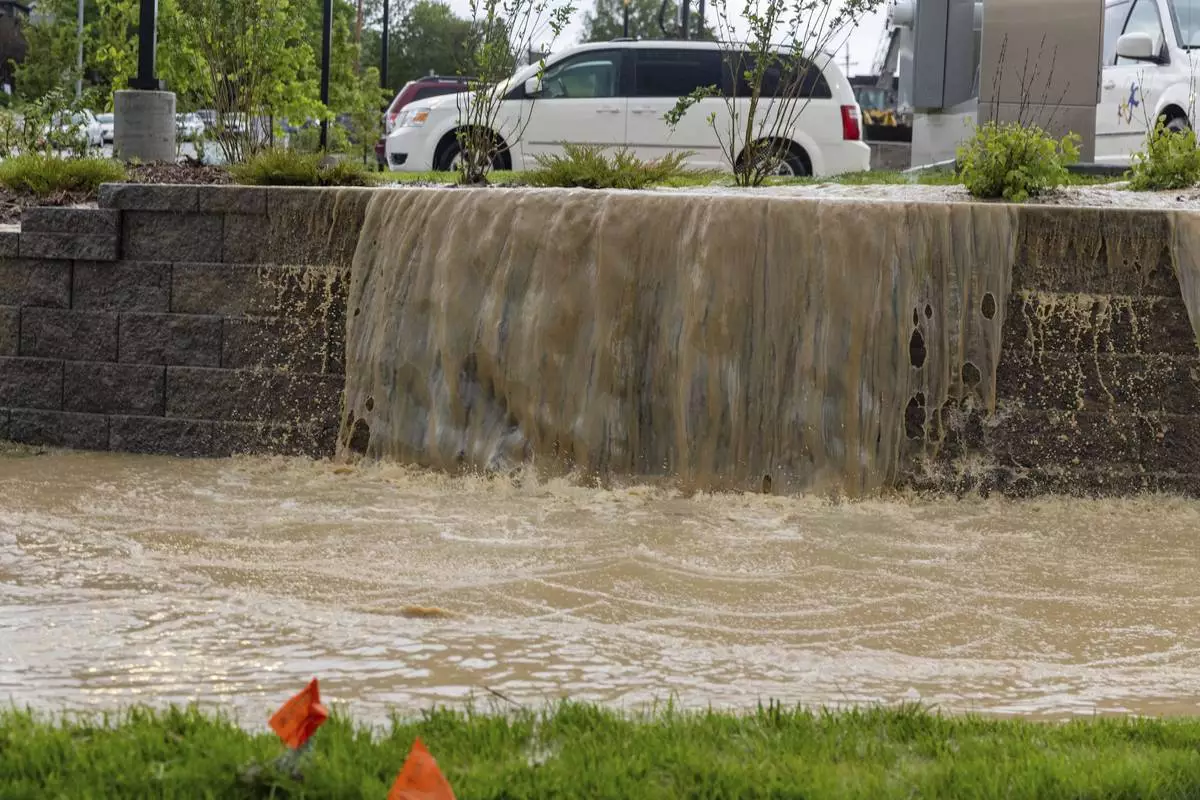
Water pours out of a parking lot onto the ground in Omaha, Neb. on Tuesday, May 21, 2024. (Chris Machian /Omaha World-Herald via AP)





